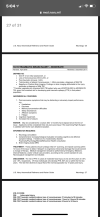Not sure about the board process and all the formalities, but in primary I was never airsick except for passive airsickness in spins. In T-45s, I never got airsick until TACFORM stage, where I puked through every flight. I was very nervous about this when BFM would start, but to my surprise I didn't even get passively airsick. I had no issues with airsickness in the FRS or fleet from then on (also, T-45 TACFORM is not how it's done in gray airplanes). I seriously thought I was done with this community during TACFORM. Everybody is different, but it is possible you will get over it. Don't quit until you truly are unable to continue no matter what.
That is refreshing to hear, that is very similar to my situation. It started with TACFORM and it’s just made me nervous if it would continue to hinder my performance in later stages. So it sounds like I just need to continue trying to power through and hopefully my body will adjust as time goes on. Thank you for the reply!



 ). It also took me some time to understand that leaving my water bottle (or dip spit bottle) in the designated cup-holder in the E-2 was somehow FOD.
). It also took me some time to understand that leaving my water bottle (or dip spit bottle) in the designated cup-holder in the E-2 was somehow FOD.